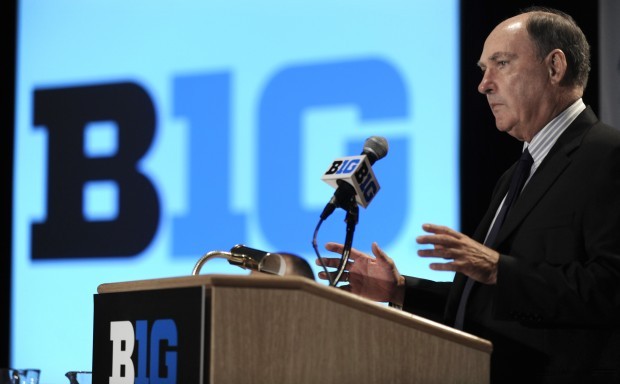My impromptu road trip to Long Beach caused me to miss a variety of kinda-newsworthy things over the past several days. This is where I summarize all those things in one way-too-long post:
Miami is "committed" to the ACC: Yeah ...
Hurricanes athletic director Shawn Eichorst released a statement Friday saying, among other things, that Miami has "not engaged in any formal or informal discussions with any other conferences" and that the school continues to believe in the appeal and strength of the ACC.... until an opportunity for discussions actually presents itself or Florida State bails for the Big 12 or whatever. Present-tense phrases like "are committed" and "we have not engaged in any discussions" mean nothing about plans/intentions going forward and should be taken with a ginormous lick of salt.
The Hurricanes began play in the ACC in 2004.
"We could not be more proud than to call the ACC our home," Eichorst wrote in a statement. "We are confident in our progress and in our accomplishments, yet there is still much work to be done. We are committed to the ACC and to doing our part to continue the tradition of excellence across the board. In that regard, we have not engaged in any formal or informal discussions with any other conferences."
Clemson isn't even pretending:
"We've not had any contact from any league," Clemson board chairman David Wilkins said Thursday. "If we receive a viable option, a viable proposal, that is presented to us by any league, we will consider it."Translation: Looking for good home for Tiger-themed program with history of mediocrity but awesome pregame entrance. $20 million a year OBO.
To be honest, I have no idea what's gonna happen with the ACC but couldn't possibly be more skeptical of the things people say about commitment when money is involved. See: Coaches, all of them.
The Big West and the Big East all at once: Boise State is headed to the Big East. For real. Here's the update from the conference meetings:
Boise State, which has been in recent talks with the Mountain West Conference about staying in the league instead of leaving next year, has reaffirmed its commitment to join the Big East, a conference official told ESPN's Joe Schad on Friday.This update has been brought to you by the Big West, which offered up a home for Boise State's non-revenue sports (they'll need one after the WAC is done falling apart), thus making Boise's decision a lot easier and making the Big East a much more viable conference than it would have been had Boise reneged and gone back to the Mountain West. In other words, everybody wins (except the Mountain West).
BTW, all the stuff I wrote a couple weeks ago about the cost-benefit analysis is much less relevant with the option to move only football to the Big East, which is minimally stronger than the Mountain West but will certainly bring in more money (probably about $5 million a year more) and might be able to retain its BCS autobid. I'll forgo the standard complaint about the absurdity of the Big East's geography and just try to ignore the even absurder absurdity of the Big East's best program being part of a school that's officially a member of the Big West.
Bill Stewart is gone: There's not much to say here. The guy was a well-liked but totally unqualified offensive line coach who had one memorable game as Rich Rodriguez's fill-in, a couple of predictably disappointing seasons and then one of the strangest, most awkward exit transitions in the history of ever. In other words, the meaningful portion of his career was short but eventful; he went 28-12 and died at the relatively young age of 59.
The good times:
It probably means something that the statements that came out in the days right after his death had nothing to do with that ridonkulous game and everything to do with the impact he made as a "person," a "friend," a "father" and an "inspiration."
Landry Jones needs a friend: This seems potentially problematic:
Oklahoma announced Tuesday that receivers Jaz Reynolds, Trey Franks and Kameel Jackson are suspended indefinitely for a violation of team rules.The Jackson thing was obviously expected; the others not so much. Reynolds was third on the team last year with 41 catches for 715 yards and five touchdowns and would be a significant loss, especially with Ryan Broyles gone. Kenny Stills is pretty dang good and a legitimate No. 1 wideout, but depth might be an issue since Reynolds and Frank are the only other scholarship receivers on the roster who have ever caught a pass and might not even be on the roster by the time the season rolls around. This would be less of a concern if Fresno State transfer Jalen Saunders were eligible to play this year; he's not.
It is unclear how long the suspensions may last. Jackson announced two days ago he was transferring, which seems to indicate he would not be back. Franks was already suspended last year for two games, and his return for the 2012 campaign seems on shaky ground. Reynolds was suspended one game last season.
FWIW, OUInsider reported on the day of the suspensions that Franks is done for the year and Reynolds is out for seven games. There's been no official confirmation of that despite its odd specificity (seven games?).
Keep in mind that Landry Jones was flat-out not good last year after Broyles got hurt. Whether that continues with even less experience at receiver (at least for the first half of the year) remains to be seen.
It's Mississippi: This is the Ole Miss-iest news of the offseason:
OXFORD, Miss. (AP) -- Mississippi sophomore Nickolas Brassell has decided to transfer after losing his academic eligibility.
A timely addition for TCU: Aaron Green was a mega-recruit last year (No. 11 overall in the ESPNU 150) out of Texas who went to Nebraska and got a couple carries per game as a true freshman behind Rex Burkhead and Ameer Abdullah. The couple-carries-per-game thing was apparently fine; what wasn't fine was when spring rolled around and Green realized he was still stuck behind the same guys, with one of them (Abdullah) also just a sophomore.
Result:
Nebraska sophomore Aaron Green has decided to transfer, his father told multiple media outlets Sunday night. Green, a San Antonio native, likely will move closer to home and select a Big 12 program.That was almost a month ago but turned out to be pretty freakin' accurate:
Former Nebraska running back Aaron Green took to his Twitter account to announce his transfer decision.TCU has had a crapload of success over the last decade but hasn't (at least to my knowledge) gotten any recruit as highly touted as Green, probably because five-star dudes don't sign up to play in the Mountain West. I don't think the importance of the move to the Big 12 can possibly be overstated here, especially seeing as how Green's father specifically mentioned a plan to "select a Big 12 program." There are obviously major-conference benefits beyond the financial ones.
“I will be finishing my Football career at Texas Christian University AKA TCU!! In Dallas/Ft. Worth Texas. Go TCU!! Go #Frogs.”
As for Green, he'll have to sit out this year as a redshirt but will have three years of eligibility left starting in 2013, at which point the only other experienced back on the roster will be current sophomore Waymon James (it's worth noting that Green could have been a comparable situation at Nebraska next year if he'd have stuck it out, but it's possible that there were issues other than playing time). TCU split carries three ways last year between James, Matthew Tucker and nominal starter Ed Wesley but will have to reconfigure things next year since Wesley just quit the team for "family reasons."
BTW, Wesley was a freshman All-American in '09 and a Doak Walker semifinals in 2010, so that loss isn't insignificant. At least there's depth and additional talent coming through the pipe.
R U SURE??? Rob Bolden is not transferring. Not today.
The rumor mill had been churning in high gear for the past several days that Penn State junior quarterback Rob Bolden would transfer.FYI, Bolden was as bad in the spring game (three picks?!?) as he was for most of last year (39.3 percent passing lol) and is probably gonna end up sitting behind Matt McGloin and/or Paul Jones if either one is capable of successfully completing a forward pass, which isn't a certainty but is more likely than Bolden suddenly becoming a competent quarterback. I have no idea why he's still at Penn State; he probably won't be by August ... or maybe tomorrow.
But the Centre Daily Times reports that Bolden is staying with the Nittany Lions, quoting his high school position coach. Penn State officials also confirmed that Bolden was back on campus.
Settle down, USC: There will come a point -- probably in about 2015 -- when USC's depth will be craptacular because of the massive scholarship limitations. This is not debatable. Whether this craptacular depth will ever be relevant is another matter entirely since the chances of needing a third-stringer go down quite a bit when all the guys on the two-deep are eleventy-star high school All-Americans who had 43 billion offers.
Ty Isaac is one of those guys:
Ty Isaac, the nation's No. 1 running back, verbally committed to USC earlier today.Isaac's commitment in and of itself didn't mean a whole lot but was preceded by commitments from Justin Davis, another five-star running back who picked USC the day before Isaac did; Max Browne, the consensus top QB in the country; and overall-top-10 defensive end Kenny Bigelow.
He made the announcement via Twitter.
"Committed to The University of Southern California," he tweeted shortly before 10 a.m. CDT this morning.
The 6-foot-2, 215-pound Isaac is the nation's No. 8 overall recruit.
USC has only seven 2013 commits yet has more Rivals 100 guys (six) than anybody other than Michigan and Texas, which is almost as laughable as the fact that USC had the highest average star ranking of any team in the country last year at 4.07 and has somehow gone up this year to an absurd 4.28. 4.28!!!
The NCAA wields a powerful hammer:
Powerful.
Asher Clark chose poorly: Asher Clark was kicked out of the Air Force Academy last week -- less than a week before graduation -- due to some drug-related shenanigans that are incomprehensible to me. Details:
Air Force tailback Asher Clark has been kicked out of school as a result of an investigation into illegal drug use, The Gazette of Colorado Springs has reported, citing unnamed sources. School spokesman David Cannon confirmed to the newspaper that Clark, a four-year starter for the Falcons, is no longer enrolled but would not comment further, referring to the Privacy Act.This really has no bearing at all on Air Force football since he was a senior last year and would have been shuffling off the eligibility coil anyway; I'm just including it here because the story popped up on my headline feeds and I figured it was worth mentioning, even if just to point out the irrelevance in terms of football and the stupidity in terms of life.
According to The Gazette, the school said in January it had suspected at least 15 students were involved in illegal drug use, findings that stemmed from an academy investigation that eventually expanded to involve 31 cadets, some of whom were student-athletes.
Clark leaves school (involuntarily, of course) second on the school's all-time rushing list with 3,594 yards but with zero degrees. Ugh.
DeAnthony Arnett is good to go: The NCAA actually did something logical (!) last week, granting DeAnthony Arnett's request to play immediately at Michigan State.
A little background: Arnett was a relatively big-time recruit who went to Tennessee, caught 24 passes for 242 yards and two touchdowns last year as a freshman and then decided he wanted out of that tire fire in order to be closer to his grandfather, who lives in Saginaw (Sparty country) and is on dialysis. He transferred a couple months ago and filed a hardship waiver with the NCAA; the decision was the correct one given the family situation.
A quick glance at Michigan State's depth chart from last year shows the following at wideout: B.J. Cunningham (graduated), Keshawn Martin (graduated), Keith Nichol (graduated). The leading returning receiver: Bennie Fowler, who had two catches for 20 yards. In other words, playing time will be readily available, especially for a guy like Arnett, who became the most talented receiver on the roster the moment he transferred and should be the No. 1 guy for the next three years (barring injury or typical Sparty malfeasance).
Art Briles is a crazy dude: According to Kendall Wright, Baylor did not use a playbook last year. Here's the exact quote:
“We didn't huddle at Baylor and we didn't have a playbook. If we had a new play or something, we'd just draw it and go out there and run it."I have no idea how to react to that. Amazement?
Just because: The results from the Texas Senate race are in:
Hilarious. Please note that, based on the margin of error, Craig James might actually have finished with negative votes, which isn't really possible but might be if the candidate in question is as universally reviled as Craig James.
I cede the floor to Mike Leach (this is from a random Q&A he did a couple weeks ago via Reddit):
How much do you hate Craig James, I mean seriously?Yup.
I think my opinion is consistent with most of the rest of America's.

























